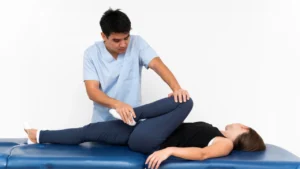Hand ligament injuries are more common than you might think, especially given how much we rely on our hands for daily activities. Whether you’re an athlete, a musician, or someone who spends a lot of time typing on a keyboard, your hands are constantly at work. But when something goes wrong—like a sudden fall or repetitive strain—it can lead to ligament injuries that impact your ability to use your hands effectively. Fortunately, if you’re in need of expert care, a physiotherapist in Park Street can provide specialized treatments to help you recover.
Understanding Hand Ligaments
Before diving into the specifics of injuries, let’s take a moment to understand what ligaments are and their role in hand function. Ligaments are tough, fibrous tissues that connect bones to other bones. In the hand, they are crucial for providing stability while also allowing the flexibility needed for complex movements like gripping, pinching, and typing.
Common Types of Hand Ligament Injuries
When it comes to hand ligament injuries, there are several types you might encounter, each with its own set of challenges.
Sprains
Sprains are one of the most common ligament injuries and can vary in severity:
- Grade 1: Mild stretching without tearing
- Grade 2: Partial tearing of the ligament
- Grade 3: Complete rupture of the ligament
Tears and Ruptures
A tear in a ligament can be partial or complete. Partial tears might only cause minor discomfort and instability, while complete tears can lead to significant functional loss.
Thumb Ulnar Collateral Ligament (UCL) Injury
The UCL in the thumb is particularly vulnerable, especially in activities involving forceful gripping or falls. This injury is often referred to as Skier’s Thumb or Gamekeeper’s Thumb, depending on how it occurs.
Finger Ligament Injuries
Ligament injuries in the fingers often affect the Proximal Interphalangeal (PIP) and Distal Interphalangeal (DIP) joints, leading to pain and difficulty with finger movements.
Causes of Hand Ligament Injuries
Understanding the causes of these injuries can help in prevention and early intervention:
- Trauma and Accidents: A fall or direct blow can overstretch or tear ligaments.
- Sports-Related Injuries: Sports like skiing, basketball, or tennis put hands at risk due to the intense strain on ligaments.
- Overuse and Repetitive Stress: Continuous use of hands in activities like typing, playing an instrument, or certain manual labor tasks can gradually wear down ligaments.
Symptoms of Hand Ligament Injuries
Identifying a ligament injury early can significantly improve the outcome. Common symptoms include:
- Pain and Tenderness: Often the first sign, localized around the injury site.
- Swelling and Bruising: Accompanies the pain, indicating internal damage.
- Weakness and Instability: Affected hand feels weak or unstable, particularly during certain movements.
- Limited Range of Motion: Difficulty moving the hand or fingers as usual.
Diagnosis of Hand Ligament Injuries
If you suspect a hand ligament injury, seeking professional diagnosis is crucial. A physiotherapist in Park Street can provide a thorough assessment and recommend the best course of action. Typically, a healthcare provider will start with a physical examination to assess the range of motion, strength, and pain levels. Imaging techniques such as X-rays, MRI, or ultrasound may be used to confirm the extent of the injury.
Physiotherapy as a Treatment Option
Physiotherapy plays a vital role in the treatment of hand ligament injuries. Early intervention with physiotherapy can speed up recovery, minimize pain, and restore function. If you’re near Park Street, visiting a physiotherapist on Park Street can be an excellent first step towards recovery.
Physiotherapy Treatments for Hand Ligament Injuries
Various physiotherapy techniques are used depending on the type and severity of the injury.
Manual Therapy
Manual therapy involves hands-on techniques to mobilize the joints, reduce stiffness, and improve hand function. Joint mobilization and manipulation are common practices in this approach.
Therapeutic Exercises
These exercises focus on strengthening the muscles around the injured ligament and improving flexibility. Specific exercises might include grip-strengthening activities or stretching routines tailored to your injury.
Splinting and Taping
A splint or tape might be applied to protect the injured ligament while it heals, providing stability and preventing further damage.
Pain Management Techniques
To manage pain, physiotherapists may use a combination of ice, heat, and electrical stimulation. These methods help reduce inflammation and provide relief from discomfort.
Rehabilitation Timeline
Recovery from a hand ligament injury doesn’t happen overnight. The rehabilitation process is typically divided into phases, starting with acute care to reduce pain and swelling, followed by strengthening exercises and finally, functional training to restore full hand function. Depending on the injury’s severity, recovery can take anywhere from a few weeks to several months. Your physiotherapist in Park Street will guide you through this process.
Preventing Hand Ligament Injuries
Prevention is always better than cure. To protect your hand ligaments:
- Warm-Up and Stretch: Before engaging in sports or strenuous activities, take time to warm up and stretch your hands.
- Use Protective Gear: When participating in activities like skiing or cycling, use protective gear to prevent falls and direct impacts.
- Ergonomic Adjustments: If your job or hobbies involve repetitive hand movements, consider making ergonomic adjustments to your workspace or technique.
When to See a Specialist
Not all hand ligament injuries require immediate medical attention, but certain signs should prompt a visit to a specialist:
- Persistent pain that doesn’t improve with rest
- Noticeable instability in the hand or fingers
- Inability to perform regular activities due to hand weakness
If you’re experiencing any of these symptoms, consulting a physiotherapist on Park Street can help you determine the severity of the injury and the appropriate treatment plan.
Complications of Untreated Hand Ligament Injuries
Ignoring a hand ligament injury can lead to long-term issues such as chronic pain, instability, and reduced hand function. Early treatment is crucial to prevent these complications.
Surgical Intervention for Severe Cases
In cases where the ligament is severely damaged, surgery may be necessary. This is often the case for complete ruptures or injuries that don’t respond to conservative treatments. Surgical options might include ligament repair or reconstruction.
Post-Surgery Physiotherapy
After surgery, physiotherapy becomes even more important. The focus shifts to rehabilitation, where exercises are designed to restore strength and flexibility to the hand. Consistent physiotherapy can significantly improve post-surgery outcomes. A physiotherapist in Park Street can create a personalized rehabilitation plan to ensure the best possible recovery.
Conclusion
Hand ligament injuries, while common, can be effectively managed with the right treatment approach. Early diagnosis, followed by a tailored physiotherapy plan, can help you regain full function and prevent future injuries. Remember, your hands are one of your most valuable tools—take care of them! If you’re in the area, don’t hesitate to reach out to Kamalika’s Physiotherapy, physiotherapist in Park Street for professional guidance and support.
FAQs
Minor injuries might heal with rest, but more severe ligament injuries often require physiotherapy or surgery to fully recover.
Recovery time varies depending on the severity, but it typically ranges from a few weeks to several months.
Yes, strengthening and stretching exercises can help maintain ligament health and prevent injuries. A physiotherapist in Park Street can guide you through a suitable exercise routine.
Avoid putting strain on the injured hand, and refrain from activities that could exacerbate the injury until you’ve been assessed by a healthcare professional.
In many cases, physiotherapy can help restore full hand function, especially if the injury is treated early and the rehabilitation plan is followed diligently. Consulting a physiotherapist in Park Street can ensure you receive the best care tailored to your needs.



